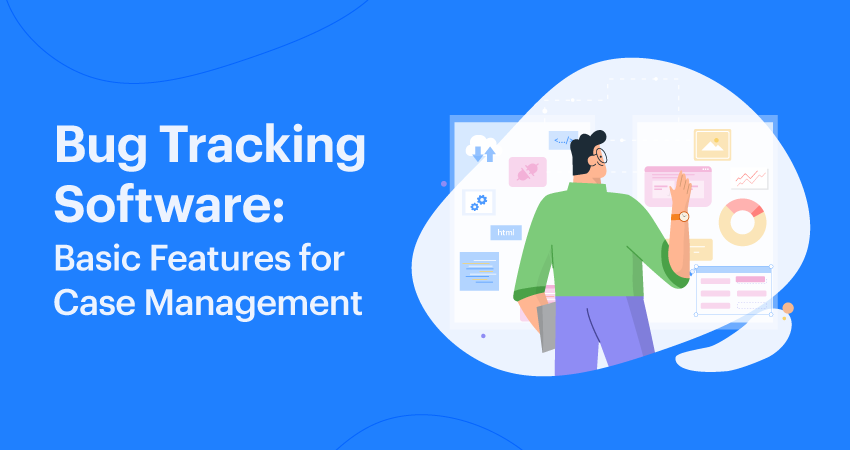Any software organization must have a solid way to handle bug tracking. Spreadsheets and emails don’t last very long when you are trying to constantly stay on top of tracking bugs, communication, and fixes.
Dedicated bug tracking software goes beyond anything you can build for yourself. It is based on case management principles that allow for a standard workflow but put the user in charge of moving each case through different steps and allowing for multiple resolutions throughout the process.
What is bug tracking software?
Bug tracking software allows you to identify, record, manage and track bugs in your software. As issues are identified, they are assigned to engineers who validate the request and work on fixes for them. The software handles how the bug fix moves from person to person while keeping the initiator in the loop.

Bug tracking software is very similar to issue tracking software or defect tracking software. It creates a database of bugs that need to be fixed while giving access to all team members who are tasked to work on them. Simply put, bug tracking software automates the process of tracking and monitoring bugs.
What are the benefits of bug tracking software?
Bug tracking software is extremely important if you have a team that is working on bug fixes collectively. It provides a slew of benefits that can make business processes more efficient.
Here are just a few of the many benefits of bug tracking software:
- It provides a single, easy-to-use interface for sharing files and information about bugs encountered.
- It maintains records and sends notifications to help a team pace, monitor, and track how bugs are fixed.
- It provides an accessible and searchable database of bugs for future reference.
- It automates manual tasks associated with capturing and fixing bugs.
What features should I look for in bug tracking software?
The best bug tracking software should ideally be streamlined to minimize time and resource costs in identifying, isolating, and fixing bugs. Here are some of the key features you should have in your bug tracking software:
1. Reporting facility
Good bug tracking software has a user-friendly interface with customizable fields for gathering pertinent information about the bug. It should include custom fields such as text, drop-down lists, or checkboxes where users can easily input the bug environment, module, severity, etc.
This allows fast and easy categorization and prioritization of issues. You can capture bugs fast, determine the root cause, and fix the problem immediately.
2. Customizable workflows
Choose bug tracking software with customizable workflows that can be adapted to industry-specific needs. Each business has unique requirements and needs unique business solutions.
3. Repository hosting
Codes are what make the software work. Whether you’re working on a software project or managing your business development software, it’s important to have a good source code repository host. Choose a bug tracker that enables source code integration.
4. Seamless integration and collaboration
Your bug tracking software should integrate well with your other digital tools like case, projects, and process management tools. Choose one that can directly export data into your tools so you can manage bug tracking from a single place.
5. Test reports, metrics, and analytics
As with all business processes, it’s important to get insights. This can help you monitor trends and occurrences that may affect work productivity. Your bug tracking software should have dashboard metrics that can easily transform collected data into graphs or charts.
6. Worklog and time tracking
A software that logs users, tasks and the time expended on them makes monitoring of issues and bugs much easier. Check if the bug issue tracking software enables individual and group progress tracking per user, bug type, or product from creation to resolution.
With a trackable history, it’s easier to trace who worked on each leg of the resolution and pinpoint any issues in the process.
7. Smart notification system
For easier progress monitoring, an automated notification system should be included in a bug tracking software. This system keeps the team on schedule by sending notifications through email or other platforms to concerned individuals. Everyone in the team is kept in the loop whenever the status of bug changes.
Where is bug tracking software used?
The basic bug tracking system allows teams to identify defects easily, measure their scope, determine their impact, and manage all the steps involved in resolving them, all from a centralized interface. Bug tracking software is commonly used in software development. Quality assurance teams and software development teams use it to identify, record and monitor errors during an application testing.
Good bug tracking software also enables customers to provide feedback after a product is released. This identifies defects that developers and quality control may have missed or those that may have occurred due to software malfunctions.
Bug tracking software can be implemented as part of integrated project management systems. Some companies now include bug tracking in their general product development process.
Bug tracking software is essential
Bugs are inevitable. Having bug tracking software decreases the chances of wasting valuable time and money resolving software issues
Simple bug tracking software is not just nice to have as add-on features of your core digital workplace, it is critical to ensuring that business processes work efficiently and seamlessly.
To make sure nothing goes wrong when you’re overseeing a project, be armed with the right tools.
So, what are you waiting for? Try Kissflow Workflow for free.